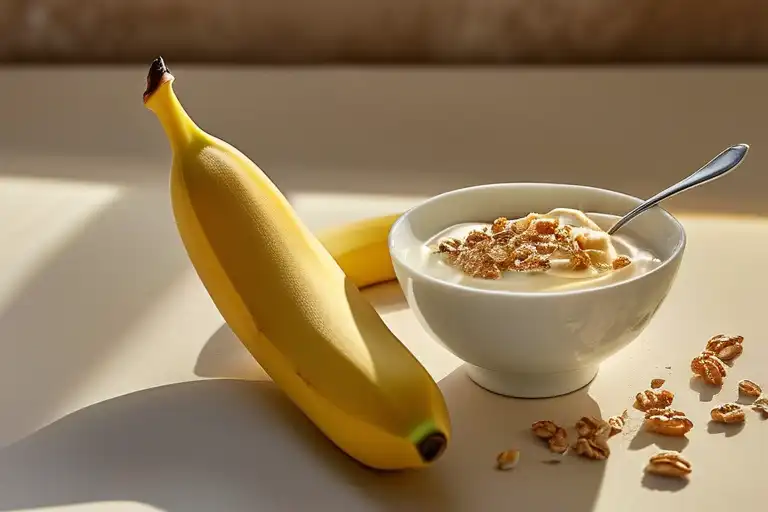Have you ever reached for a banana first thing in the morning, thinking you’re making a healthy choice? That bright yellow fruit seems like the perfect quick breakfast—natural, portable, and packed with nutrients. But what if this morning habit isn’t serving your body as well as you think?
Nutrition expert Shilpa Sadhaa, with her background in nutrition and yoga, suggests we might want to reconsider this common practice. She specifically recommends avoiding bananas on an empty stomach or pairing them with other foods like milk, nuts, or yogurt to truly optimize their benefits. This isn’t about creating food fear or complicated rules—it’s about understanding how our bodies process different foods at different times, and making simple adjustments that can significantly impact how we feel throughout the day.
Many of us grab a banana in the morning because it’s convenient and feels virtuous. We know fruits are healthy, and bananas in particular give us that quick energy boost we often need to start our day. But sometimes what seems logically healthy doesn’t quite align with how our digestive system actually works in those early hours. The relationship between empty-stomach consumption and certain foods is more nuanced than we typically acknowledge.
This exploration isn’t meant to discourage banana consumption—far from it. Bananas remain one of nature’s most perfect foods, containing potassium, fiber, and essential vitamins. Rather, we’re looking at timing and combination, those subtle factors that can transform good nutrition into optimal nutrition. It’s the difference between simply eating healthy foods and actually allowing your body to absorb and utilize all the goodness those foods contain.
Throughout this discussion, we’ll unpack the science behind why pairing matters, explore what happens physiologically when we eat bananas alone on an empty stomach, and provide practical alternatives that maintain all the convenience while enhancing nutritional benefits. The goal isn’t to add complexity to your morning routine but to offer insights that might make your breakfast choices more effective and satisfying.
We’ll keep things practical and evidence-based, focusing on what actually works rather than food trends or extreme restrictions. Because at the end of the day, nutrition should feel simple, sustainable, and genuinely supportive of how you want to feel each day.
The Nutritional Profile of Bananas and Fasting Physiology
Bananas present a fascinating nutritional paradox. While widely celebrated as nature’s convenient snack, their composition reveals complexities that demand thoughtful consumption timing. The bright yellow fruit contains approximately 32 milligrams of magnesium per medium-sized specimen—a mineral crucial for hundreds of biochemical reactions yet potentially problematic when consumed in isolation on an empty stomach.
The potassium content, often touted as bananas’ primary nutritional advantage, reaches about 422 milligrams per fruit. This electrolyte plays vital roles in maintaining fluid balance and supporting nerve function. However, the relatively high natural sugar content—roughly 14 grams primarily as sucrose, fructose and glucose—creates a rapid energy release that empty stomach conditions amplify significantly.
When we awaken after hours of fasting, our digestive system exists in a unique state. Gastric acid production increases in preparation for food, while blood sugar levels typically sit at their daily lowest point. The intestinal lining becomes more receptive to nutrient absorption without competing foods, creating both opportunity and vulnerability.
This empty stomach environment transforms how our bodies process bananas’ components. The magnesium, normally beneficial for heart health and muscle function, can create temporary electrolyte imbalances when absorbed rapidly without other food buffers. The sudden influx of simple sugars triggers corresponding insulin spikes that may lead to subsequent energy crashes—the very opposite of what most people seek from their morning meal.
Digestive enzymes that break down carbohydrates become immediately engaged with the easily accessible sugars, potentially overwhelming the system that expected a more gradual nutrient introduction. This explains why some people experience brief energy surges followed by fatigue, while others report mild digestive discomfort when consuming bananas alone first thing in the morning.
The fiber content in bananas, while beneficial for regular digestion, behaves differently on an empty stomach. Soluble fibers like pectin can create a gel-like substance that slows digestion—potentially beneficial when other foods are present but sometimes leading to temporary bloating when consumed in isolation.
Understanding this nutritional interplay helps explain why nutrition professionals frequently recommend pairing bananas with other foods. The combination with protein or healthy fats modifies the absorption rate, creating a more sustained energy release and preventing the mineral imbalances that can occur when consuming high-magnesium foods alone after prolonged fasting.
This doesn’t diminish bananas’ nutritional value but rather highlights the importance of consumption context. The same properties that make them potentially challenging on an empty stomach become significant advantages when properly combined with other foods, offering sustained energy and optimized nutrient absorption throughout the morning hours.
The Hidden Risks of Morning Banana Consumption
That morning banana seems like such a wholesome choice—quick, portable, and naturally sweet. But when consumed on an empty stomach, this tropical fruit reveals complexities that might surprise you. The very nutrients that make bananas beneficial can become problematic when introduced to an empty digestive system.
Cardiovascular Considerations
Bananas contain significant amounts of magnesium—approximately 32 mg per medium fruit. While magnesium supports numerous bodily functions, flooding your system with this mineral first thing in the morning can create an unexpected burden. Your cardiovascular system, still transitioning from overnight rest to daytime activity, may struggle to process this sudden mineral influx. Some individuals report palpitations or irregular heart rhythms after consuming bananas on an empty stomach, particularly those with existing heart conditions or electrolyte sensitivities.
The issue isn’t that bananas are inherently dangerous—it’s about timing and context. Your body’s mineral balance reaches its most delicate state after hours of fasting, making morning the least ideal time for concentrated mineral intake without other food buffers.
Blood Sugar Rollercoaster
Here’s where the banana’s simplicity works against it. A medium banana contains about 27 grams of carbohydrates, with sugars comprising approximately 14 grams. When eaten alone, these simple sugars enter your bloodstream rapidly, causing a sharp insulin response. This spike often leads to a subsequent crash, leaving you feeling fatigued and hungry within hours—the opposite of what you want from a breakfast intended to sustain you through the morning.
This glucose volatility affects more than just your energy levels. Repeated blood sugar spikes can contribute to insulin resistance over time, particularly concerning for those with prediabetic tendencies or metabolic concerns. The banana’s glycemic index of approximately 51 (moderate range) becomes significantly more impactful when consumed without protein, fat, or fiber to moderate absorption.
Digestive Discomfort and Nutrient Absorption
Empty stomach digestion operates differently than after meals. Your gastric acid concentration remains high after overnight fasting, creating an environment where certain foods can cause irritation. Bananas, while generally gentle, contain compounds that may trigger acid reflux or indigestion in sensitive individuals when consumed alone.
Furthermore, the efficiency of nutrient absorption changes when foods are introduced to an empty system. Some studies suggest that the magnesium in bananas might not be optimally absorbed without accompanying nutrients, potentially reducing the very benefits you’re seeking. The fiber content, while beneficial for digestion when properly balanced, can cause bloating or gas when the digestive system isn’t prepared for its arrival.
This doesn’t mean you should avoid bananas altogether—far from it. The risks emerge specifically from the combination of empty stomach conditions and banana consumption. Understanding these mechanisms helps explain why nutrition experts consistently recommend pairing bananas with other foods rather than consuming them in isolation first thing in the morning.
The temporary nature of these effects means they’re largely preventable through simple adjustments to how and when you enjoy this popular fruit. The subsequent sections will explore practical strategies to transform your banana consumption from potentially problematic to optimally beneficial.
The Right Way to Enjoy Bananas
When that morning hunger strikes, reaching for a banana seems like the perfect solution – it’s convenient, nutritious, and satisfying. But as we’ve explored, enjoying this tropical fruit requires some thoughtful pairing to maximize its benefits while minimizing potential drawbacks. The good news is that with a few simple adjustments, you can transform your banana consumption from potentially problematic to perfectly optimized.
The Power of Pairing
The secret to unlocking banana’s full nutritional potential lies in strategic combinations. Pairing bananas with other foods creates a balanced nutritional profile that supports sustained energy release and optimal nutrient absorption.
Dairy products like milk or yogurt make excellent companions for bananas. The protein and fat content in dairy helps slow down the digestion of banana’s natural sugars, preventing those sharp blood sugar spikes. A simple banana smoothie with Greek yogurt or a bowl of oatmeal with sliced banana and milk creates a complete breakfast that will keep you satisfied for hours. The calcium in dairy also complements banana’s potassium, supporting overall electrolyte balance.
Nuts and seeds offer another brilliant pairing opportunity. The healthy fats in almonds, walnuts, or chia seeds not only slow sugar absorption but also enhance the absorption of fat-soluble nutrients. Try sprinkling chopped nuts over banana slices or blending them into a nut butter banana sandwich. The combination of banana’s quick energy with nuts’ sustained release creates perfect energy synchronization.
Whole grains complete the banana optimization triangle. Oatmeal, whole wheat toast, or quinoa provide complex carbohydrates and fiber that work synergistically with banana’s nutrients. The fiber in whole grains helps regulate the digestion process, while the combination of simple and complex carbohydrates provides both immediate and lasting energy.
Timing Matters
When you eat bananas can be just as important as how you eat them. While the morning empty stomach approach isn’t ideal, incorporating bananas into your breakfast routine with proper pairing works beautifully. The first meal of the day sets your metabolic tone, and a well-balanced banana-containing breakfast can provide sustained energy without the crash.
Post-workout emerges as another optimal timing window. After exercise, your body needs quick carbohydrates to replenish glycogen stores and protein to repair muscle tissue. A banana paired with a protein source like whey protein or Greek yogurt makes an excellent recovery snack. The potassium in bananas also helps replace electrolytes lost through sweat.
Some people find that enjoying bananas as an afternoon snack helps combat that typical 3 PM energy slump. The natural sugars provide a quick pick-me-up, while proper pairing ensures the energy boost lasts until dinner without disrupting appetite.
Personalized Banana Approaches
Individual health considerations should guide how you incorporate bananas into your diet. For those managing diabetes, portion control and pairing become particularly important. Half a banana paired with protein and healthy fats makes a better choice than a whole banana alone. Monitoring blood sugar response to different banana preparations can help identify what works best for your individual metabolism.
Fitness enthusiasts might appreciate bananas as part of their pre-workout nutrition. The easily digestible carbohydrates provide quick energy, while pairing with a small amount of protein can support muscle performance during training sessions.
For individuals with digestive sensitivities, ripe bananas often work better than underripe ones. The starch in underripe bananas can be more difficult to digest, while ripe bananas contain more soluble fiber that may be gentler on sensitive systems.
Practical Implementation
Creating banana-friendly meals doesn’t require culinary expertise. Start your day with oatmeal topped with banana slices and almond butter. Blend a smoothie with banana, spinach, Greek yogurt, and a tablespoon of chia seeds. Enjoy whole grain toast with peanut butter and banana slices for a satisfying snack.
Remember that ripeness affects nutritional profile. While ripe bananas have higher sugar content, they also contain more antioxidants. Choose ripeness based on your needs – slightly green bananas for lower sugar impact, yellow bananas for balanced nutrition, or spotted bananas for maximum antioxidant benefits.
The goal isn’t to avoid bananas but to enjoy them intelligently. By understanding how to pair, when to consume, and what considerations matter for your individual needs, you can make bananas work beautifully within your nutritional pattern. This approach transforms potential problems into nutritional opportunities, allowing you to benefit from banana’s wonderful nutrients while avoiding the pitfalls of improper consumption.
What makes this approach work is its simplicity and adaptability. You don’t need special ingredients or complicated recipes – just an understanding of how different foods work together. With this knowledge, you can confidently incorporate bananas into your diet in ways that support rather than challenge your health goals.
Healthy Banana Breakfast Recipes
Turning scientific insights into practical morning meals transforms potential dietary pitfalls into nourishing opportunities. These recipes deliberately combine bananas with complementary ingredients to optimize nutrient absorption while minimizing the risks associated with consuming them on an empty stomach.
Banana Nut Yogurt Bowl
This combination addresses multiple concerns simultaneously: the yogurt’s protein and fat content slows sugar absorption, while nuts provide magnesium-balancing nutrients. Begin with one ripe banana sliced into coins. Select Greek yogurt for its higher protein content—about 150 grams provides a solid nutritional foundation. Add two tablespoons of mixed nuts—almonds and walnuts work particularly well for their magnesium and healthy fat profiles. A drizzle of honey (optional) and a sprinkle of cinnamon complete this balanced breakfast that takes mere minutes to assemble yet sustains energy levels for hours.
Oatmeal with Banana and Milk
Oatmeal creates a protective buffer for banana’s natural sugars while adding valuable soluble fiber. Prepare half a cup of rolled oats using milk instead of water—the dairy’s fat content further moderates glycemic response. While the oatmeal is still warm, stir in one sliced banana, allowing it to soften slightly and release its natural sweetness throughout the mixture. The heat partially breaks down the banana’s starch into more digestible forms, while the oats provide sustained energy release. This warm, comforting breakfast proves particularly valuable during colder months or for those with sensitive digestion.
Whole Grain Banana Sandwich
For those preferring a portable breakfast option, this unconventional approach offers surprising benefits. Toast two slices of whole grain bread to provide complex carbohydrates and fiber. Spread a thin layer of nut butter—almond or peanut butter work well—to add protein and healthy fats. Arrange banana slices on one slice, then sprinkle with chia seeds or flaxseeds for additional fiber and omega-3 fatty acids. The combination creates a satisfying meal that prevents blood sugar spikes while offering a variety of textures and flavors.
These recipes demonstrate that avoiding bananas on an empty stomach doesn’t mean eliminating them from your morning routine entirely. By thoughtfully combining them with other macronutrients, you can enjoy bananas’ natural sweetness and nutritional benefits while mitigating potential drawbacks. The key lies in recognizing that food synergy—how ingredients work together—often proves more important than individual components alone.
Experiment with these basic templates according to your preferences and dietary needs. The banana nut yogurt bowl might incorporate different spices like nutmeg or cardamom. The oatmeal could be prepared with almond milk and topped with berries for additional antioxidants. The sandwich might use different nut butters or seed spreads. This flexibility allows you to maintain nutritional balance while keeping your breakfast routine varied and enjoyable.
Remember that individual responses to food combinations can vary. Pay attention to how your body reacts to these meals—some might find they need more protein, while others might prefer more complex carbohydrates. The fundamental principle remains consistent: bananas make an excellent breakfast component when properly paired with other foods that moderate their metabolic impact.
Common Questions and Expert Advice
When it comes to eating bananas, several questions tend to surface repeatedly. Let’s address some of the most common concerns with practical, evidence-based guidance.
When is the best time to eat bananas?
The timing question deserves more nuance than a simple answer. For most people, consuming bananas about 30-60 minutes after a meal works well, as this allows for better digestion and nutrient absorption. The mid-morning or mid-afternoon periods often serve as ideal windows—when energy levels might dip but the digestive system isn’t empty. Some fitness enthusiasts prefer bananas about an hour before workouts for quick energy, while others find them helpful post-exercise for recovery. The key lies in observing how your body responds and adjusting accordingly.
What about banana ripeness?
Ripeness significantly affects both nutritional content and digestibility. Greenish bananas contain more resistant starch, which acts like fiber and may cause more digestive discomfort when eaten alone. As bananas ripen, the starch converts to simple sugars, making them easier to digest but potentially causing quicker blood sugar spikes. For most people, a yellow banana with slight green at the ends represents the sweet spot—balanced in sweetness and digestibility. Those with blood sugar concerns might prefer slightly underripe bananas, while people seeking quick energy might choose fully ripe ones.
How should I select and store bananas?
Choose bananas based on when you plan to consume them. If you need them to last several days, select fruits with more green coloration. For immediate use, yellow bananas with brown speckles often offer the best flavor. Store bananas at room temperature away from direct sunlight. Once they reach your preferred ripeness, you can refrigerate them—the peel will darken but the fruit inside will remain preserved for another week. For longer storage, peeled bananas can be frozen in airtight containers for smoothies or baking.
Are there specific concerns for different health conditions?
Individuals with diabetes should be particularly mindful about pairing bananas with protein or healthy fats to moderate blood sugar response. Those with kidney issues may need to monitor potassium intake, though banana consumption rarely causes problems when part of a balanced diet. People with latex allergies should note that bananas contain proteins similar to latex and might trigger reactions. For most digestive concerns, the combination approach—bananas with other foods—usually addresses potential issues.
Expert Recommendations for Daily Consumption
Most nutrition professionals suggest one to two bananas daily as part of a varied fruit intake. They emphasize that bananas should complement, not replace, other fruits and vegetables in your diet. The focus should always be on combination eating: bananas with a source of protein, healthy fats, or both. This approach maximizes nutritional benefits while minimizing potential drawbacks.
Final Principles to Remember
The simplest guidance might be this: think of bananas as team players rather than solo performers. They work wonderfully when combined with other foods, whether it’s nut butter, yogurt, oatmeal, or whole grain toast. Avoid making bananas your first food of the day without company, and pay attention to how your body responds after eating them. Like most nutritional advice, individual needs vary—what works perfectly for one person might need adjustment for another.
These suggestions aren’t about creating food anxiety but about helping you enjoy bananas in ways that make your body feel its best. When in doubt, remember that food combining usually solves most banana-related concerns, allowing you to enjoy this nutritious fruit without hesitation.
Making Smart Choices with Bananas
When it comes to enjoying bananas, the simplest advice remains the most valuable: avoid eating them alone on an empty stomach. This isn’t about creating unnecessary restrictions in your diet, but rather about understanding how to maximize the nutritional benefits of this wonderful fruit while minimizing potential discomfort.
The most immediate action you can take is to pair bananas with other foods. Keep some almonds or walnuts in your pantry to toss with your morning banana. Have yogurt or milk readily available—these combinations not only taste great but transform your banana into a more balanced nutritional package. For those mornings when you’re particularly rushed, even spreading a tablespoon of nut butter on banana slices can make a significant difference in how your body processes the fruit.
Consider timing as well. If you do choose to eat a banana, making it part of a larger meal rather than a standalone snack can help mitigate the rapid sugar absorption and magnesium impact. The difference between eating a banana fifteen minutes before your oatmeal and mixing it into your oatmeal might seem small, but your digestive system will notice.
For those with specific health considerations—whether managing blood sugar levels, focusing on heart health, or dealing with digestive sensitivities—these recommendations become particularly important. What works for one person might need adjustment for another, and that’s perfectly normal in nutrition. The key is paying attention to how your body responds and making adjustments accordingly.
If you’ve found these insights helpful, you might wonder about other common food combinations and timing considerations. Many everyday foods have similar nuances—when to eat them, what to pair them with, and how to prepare them for optimal nutrition. These details often make the difference between food merely filling you up and truly nourishing your body.
Exploring these nutritional relationships can become quite fascinating. The way foods interact with each other and with our bodies creates a complex nutritional landscape that’s worth understanding, especially if you’re someone who values making informed choices about what you eat. It’s not about developing food anxieties, but rather about cultivating food awareness.
Remember that nutrition science continues to evolve, and what we understand about food combinations and timing may develop over time. The current understanding suggests that being mindful about how and when we eat bananas—and other foods—can contribute to better digestive comfort and more stable energy levels throughout the day.
Start with small changes. Notice how you feel after eating bananas in different contexts. Keep track of what works for your body specifically. Nutrition may have general guidelines, but individual responses can vary, and your personal experience ultimately matters most in determining what eating approaches serve you best.





